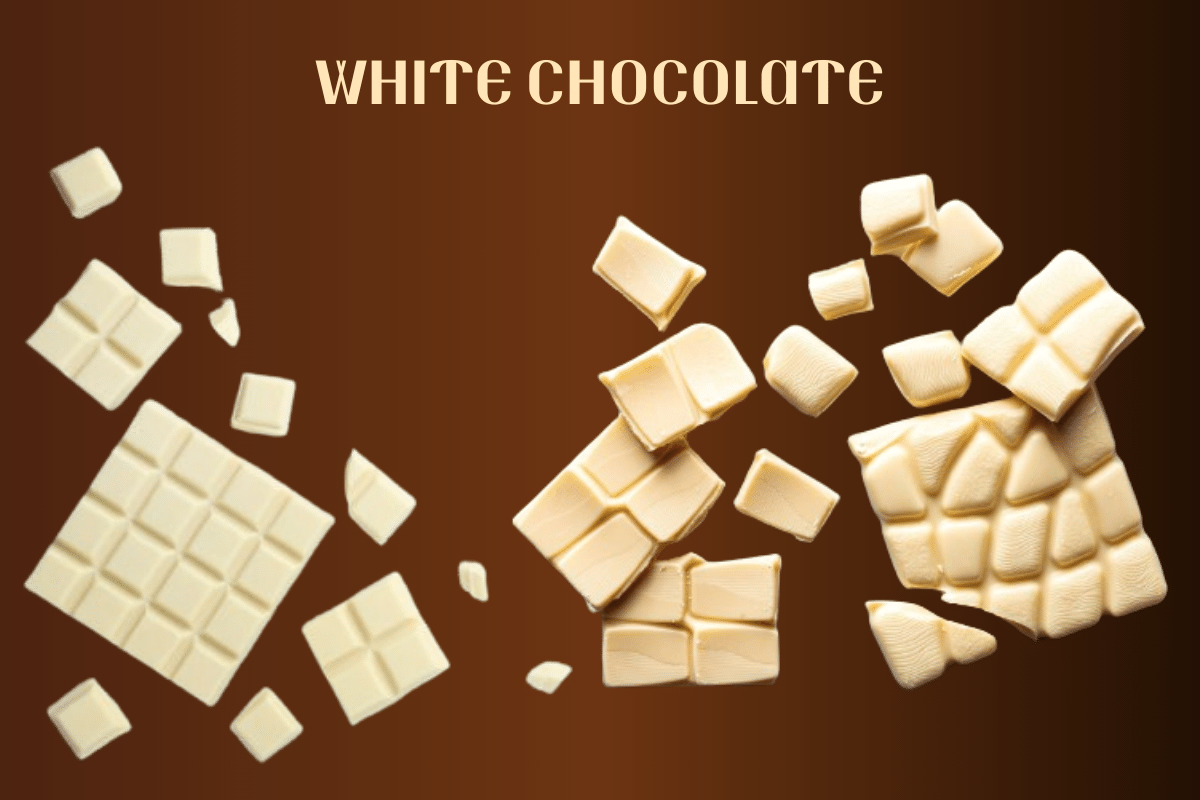| Ingredients | |
| Icing Sugar or Powdered Sugar | 2 Tbsp |
| Milk Powder | 6 tbsp |
| Coconut oil Cocoa Butter or vanaspati ghee | 4 tablespoon |
| Vanilla flavor (Optional) | 1/8 teaspoon or (5 to 10 drops) |
| Pinch of Salt (Optional) | 1 Pinch |
Tools for making homemade White chocolate
While various tools can be helpful, all items are not necessary if you’ve pre-ground your ingredients. You can adjust them on the basis of your need.
1 Double Boiler or Heatproof Bowl:
You can use a Double boiler or heatproof bowl over a pot of simmering water to melt the cocoa butter. This will help to protect from overheating or burning.
2 Whisk
This tool is essential for mixing melted cocoa butter with powdered sugar and powdered milk. It ensures a fluffy and smooth texture.
3 Cups and Spoons
Accurate measurements are important in baking, so have measuring cups and spoons on hand for the powdered milk cocoa butter, and powdered sugar.
Wooden Spoon or Spatula
A wooden spoon or Spatula is used to mix up ingredients.
Molds or Tray:
This is not essential but if you use it will style or shape your chocolate.
Cooling Rack:
If you’re using molds, a cooling rack can help with the setting process by allowing air circulation around the chocolates.
Refrigerator:
A refrigerator is essential for cooling and solidifying the white chocolate
Chocolate Breaker or Knife
For breaking the white chocolate into pieces, have a sharp knife or a specialized chocolate breaker on hand.
Optional: Flavorings and Extracts:
If you choose to add flavorings like vanilla extract, have a small measuring spoon for precise measurements.
Optional: Salt Shaker or Pinch Bowl:
If you’re adding a pinch of salt for flavor balance, a salt shaker or a small bowl can be handy.
Instructions
Prepare for your white chocolate adventure by gathering pre-ground ingredients—powdered sugar, powdered milk, and finely chopped cocoa butter. Ready your tools in a kitchen filled with the sweet promise of a simple, sophisticated self-made treat.
Melt the Cocoa Butter:
Cut the cocoa butter into small and ununiform pieces. This helps it melt more evenly.
For this use a heatproof bowl or double boiler placed over a pot of simmering water for melting the cocoa butter and keep in mind the bowl doesn’t touch the water otherwise it may cause burning or overheating.
Combine Ingredients:
Once the cocoa butter is melted, remove it from heat. Gradually whisk in the powdered sugar and powdered milk. Continue stirring until the mixture becomes smooth and well combined.
Adding Flavor in Chocolate (Optional):
I often use the flavor in white chocolate because I love it, so if you also like this flavor then add a teaspoon of vanilla extract for flavor. You can also try other flavors like coconut extract, almond plus so on.
Add a Pinch of Salt:
If you want to enhance the flavor of your delicious chocolate you can add a pinch of salt. It will enhance the flavor. This step is optional but can add a nice balance to the sweetness.
Pour into Molds or Spread on a Tray:
Pour the white chocolate mixture into molds for individual chocolates or spread it on a parchment-lined tray for a more free-form bark-style chocolate.
Chill:
Cool the anticipation as your white chocolate masterpiece sets its allure. Nestle it gently in the refrigerator, allowing the flavors to mingle and solidify into a decadent harmony. The chill is the final touch, transforming your creation from a promise into a delectable reality.
Remove and Enjoy:
Once the white chocolate has hardened. Remove it from the molds or break it into delicious pieces if you choose the tray, unveiling the sweet results of your culinary craftsmanship.
Note
Remember that homemade white chocolate might have a slightly different texture and flavor compared to commercial white chocolate, which often contains additional ingredients like lecithin and vanilla. Add flavor and sweetness according to your taste, transforming your creation into a personalized and delightful culinary experience. Store the white chocolate in cool places to prevent it from melting, and savor its delectable texture and flavor at its finest.
FAQs
Is white chocolate made from milk powder?
No, white chocolate is not made exclusively from milk powder. While it does contain milk solids, the primary ingredient is cocoa butter. The creamy texture and sweetness in white chocolate come from a combination of cocoa butter, sugar, and milk solids, creating a uniquely indulgent treat.
How does chocolate turn white?
Chocolate turns white due to a fascinating process known as chocolate bloom. When chocolate undergoes a change, its cocoa butter rises to the surface, creating what we call chocolate bloom. There are two kinds: fat bloom, where fats move around, and sugar bloom, where sugar crystals appear. Factors like temperature fluctuations or improper storage contribute to this intriguing transformation, giving chocolate a pale appearance without compromising its essence.
Does white chocolate contain milk powder?
White chocolate contains milk solids, but it’s not as straightforward as milk powder alone. The creamy allure of white chocolate stems from a harmonious blend of cocoa butter, sugar, and milk solids, crafting a luscious treat that transcends the simplicity of powdered milk.
What is white chocolate made from?
White chocolate is crafted from a combination of ingredients, with its primary component being cocoa butter. Unlike traditional chocolate, white chocolate doesn’t contain cocoa solids, which gives it its distinct pale color. In addition to cocoa butter, white chocolate typically includes sugar, milk solids (such as milk powder or condensed milk), and flavorings like vanilla. This unique blend results in the creamy, sweet, and smooth character that defines white chocolate.
Is milk powder used in chocolate?
Yes, chocolate often employs milk powder, adding a touch of creamy magic to the mix for a uniquely delightful taste.
What are the steps of making a chocolate bar?
The journey from cocoa tree to chocolate bar involves several key steps: harvesting ripe cocoa pods, fermenting and drying the beans, roasting to develop flavor, winnowing to remove shells, grinding to create chocolate liquor, conching for texture, tempering for stability, molding into bars, and finally cooling for the perfect finish. Each of these steps contributes to the unique taste and texture of the chocolate bar you enjoy, showcasing the craftsmanship from tree to treat
What are the ingredients in a chocolate bar?
Cocoa:
The heart of chocolate is sourced from quality cocoa beans.
Sugar:
The sweetness balances the robust cocoa flavor.
Milk (if applicable):
A creamy addition to milk chocolate creates a smooth texture.
Emulsifiers (optional):
Like lecithin, aiding in texture and shelf life.
Vanilla (optional):
Adds a touch of warmth and complexity to the flavor.
Salt (optional):
Enhances overall flavor, balancing sweetness
Read more About : How to make chocolate spoons without a moulid



